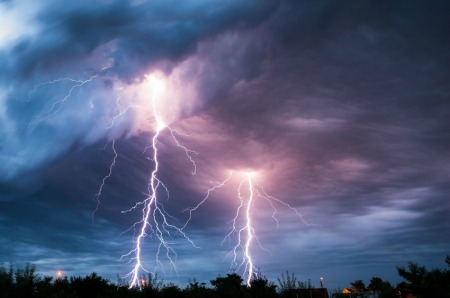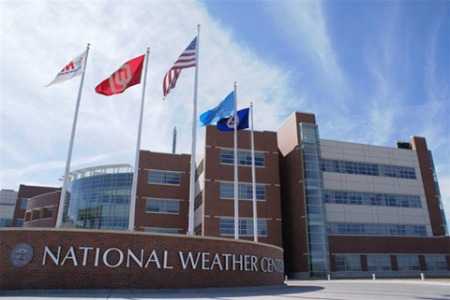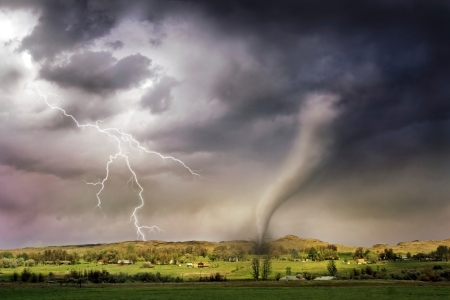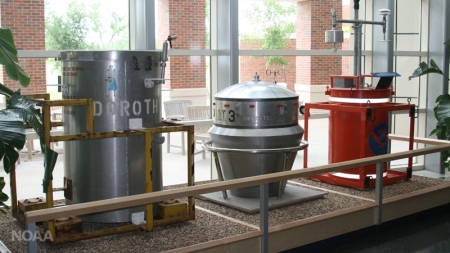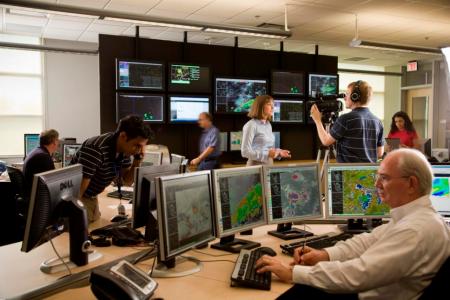
New Yorkers can sense when it’s really gonna be bad. As they brush away the first saltlike dots of snow powered by a serious Nor’easter, they reflexively raid the food stores. First go the “D” batteries. Do yourself a preemptive favor and snatch up a pile of Ds the next time you see one: Costco, a roadside table, anywhere. Your trusty old flashlight – you know, the good one – uses these big bulky power cells, just like airbody else’s does. Later go milk, bread, eggs, meat, Pampers – but like certain hardy insects, those dicey cans in the Campbell’s-soup section stare back and survive.
They laugh at us insular cityfolk, but we can read a weather map as well as you can. Hurricane Sandy happened to collide with two other weather patterns, and an oppositional weather pattern can’t remain part of such a threesome without relieving itself upon your head. The “trickle-down theory,” I guess. (Sorry about that analogy; I need a good editor.) Once again came the run on the stores, which began Saturday but hit fourth gear on Sunday. That morning, I looked at the tv weather map at my gym (MOS; I read magazines while huffin & puffin, so no earbuds for me), and this was the biggest twister I’d ever seen, a go-rilla of a storm that just beat its chest and threatened to climb the dadburn Empire State Building. How big? Look at the satellite photo above, taken late Sunday. Holy moley. I considered doing an emergency load of laundry in case things really did go blooey.
I overheard a guy at the gym telling somebody, “I took a meteorology course in college. I know better than these tv face jocks. I’m tellin ya, it’s just gonna be some heavy rain and wind. Nothin to get worried about.” I didn’t observe (aloud) that these days most major-market weatherfolk were meteorology majors at the very least, but I decided in that instant: I’m definitely doing some frickin laundry.
I laid out bottled water and flashlights in every room. Linda filled up the bathtub. If power goes out, you can’t pump water up to the 21st floor, and that includes water for the potty; I learned that during the great Northeast blackout of 2003, when we went without juice on a sweltering summer afternoon and night. (Linda was out of town, in a nice air-conditioned hotel room, for the whole event.) At least it wouldn’t be so miserably hot this time. Also, one of your first chores when the lights go out, I learned back then, is to empty the icemaker – unless you want to try and tote it around later as sloshy liquid water.
All of this was designed to deliberately tempt Murphy’s Law. You know, take an umbrella to work and it won’t rain. By Sunday afternoon, we were prepared to lose power – and if we didn’t, it would be the year’s greatest anticlimax. Most businesses, including that gym, closed late Sunday afternoon, subway service ended at 7pm, and the rest of NYC public transportation a little later. Airports? Forget about it. By Monday morning, the streets were eerily quiet (yellow cabs were still trolling). It hadn’t started to rain, but the wind was definitely picking up. Our building is on cantilevers, so during really strong winds you can hear a soft creaking and notice some back-and-forth give if you’re standing. I always imagine it’s what it must sound and feel like aboard a pirate ship. Well, we set to sea about 8am.
Mayor Mike Bloomberg – who has done one hell of a job over the years – called for evacuation of the city’s lower-lying areas. But some people felt burned by the same call during Irene in August of last year: they evacuated and then couldn’t get back for a while, even though we’d avoided a direct hit by this very nasty storm. To them, Hizzonner was crying wolf again, making something out of nothing. More meteorology experts. But as Bloomberg noted, if you stick around, you’re endangering not only your own lives, but also the lives of the emergency responders who may have to come dig you out.
The wind kept increasing as Monday wore on and Sandy, still at sea, actually found herself stronger than the day before. Exactly where she would take the left turn toward the mainland was the big question. That intermittent shrieking sound can really make you nervous if you let it. Linda noticed the next-door apartment’s windows were covered with big masking-tape Xs. She also overheard somebody downstairs advising a resident to crack the windows to equalize air pressure. A quick scoot online showed us that tape does nothing to impede the process of windows breaking (hurricane shutters and new screen and fabric products can help, but they have to go on well in advance), and opening or even just cracking a window will invite more damage than if it’s tightly sealed, because any wind that does enter will seek to exit, powerfully. This old wives’ tale started long ago during tornado-damage investigations; houses seemed to have exploded from within, so maybe an air-pressure differential was at fault. What actually would happen was this: escaping wind typically forced a roof upward, its sharp angle acting like a wing as the shear kept howling above it. The roof gained lift and went airborne and the walls fell outward, making it look like they’d been pushed from within. No underwriter believes that stuff about air pressure any more. Folks, save your tape (it does exactly zip), and don’t crack your windows (it’ll only make things worse). I love me these Internets.
One of our best friends has a magnificent beach house in Fire Island Pines. I started worrying about it – our friend’s okay; besides, Fire Island was evacuated. I mean the house – midday Monday and never quit. We’ve seen absolute real-estate carnage on that beach before, utter devastation. But as he once said, “I’d never buy a house on this beach that I couldn’t afford to lose.” It was all up to Sandy now.
As the light faded on Monday, we noticed some fairly robust trees in planters across 87th Street from our place bowing over bigger than Obama ever had! The weight of the planters was all that kept these boys over 87th Street instead of on it, twenty-one stories below. We were looking across at the former Gimbels department store, now transformed into high-end residences and film-shoot sites. (There’s a “Manhattan-background” shoot directly across from us at least twice a year. One day Linda saw Michael Douglas changing clothes!) But today, two burly guys were tying down all the plants they could, and taking photos of everything else. For the insurance claims, hmmmm? The wind was blowing so hard that I was worried the guys might topple over the side.

A leaf convention held Tuesday morning on Fifth Avenue at Central Park.
Tuesday morning, good old Murphy’s Law had favored us and we still had power. But I couldn’t say the same for so many of our friends. The lights went out in Greenwich Village about 8:30pm Monday, and the flooding throughout lower Manhattan was beyond belief. Fortunately, we live in Carnegie Hill on the Upper East Side, emphasis on the word “hill.” But “most of Manhattan below Midtown,” according to the Times, went dark, about 250,000 customers. (A “customer” can be a whole family, even an entire building.) Add Westchester County and the powerless total rose to 634,000. And that’s just in New York. Two million customers in Jersey, which is where the storm decided to make land. Six hundred thousand in Connecticut. Emergency shifts of gas and electric workers had been bussed in, but it wasn’t clear whether they could even begin until the winds had died down, maybe by Wednesday. They were still gusting fairly hard Tuesday morning, but we felt a bit of reassurance: some trees might still fall, but Monday afternoon and evening probably represented the worst juju this storm could throw at our area. Monday night after I was already asleep, Linda closed the blinds at every window. The howling had gotten much worse, but I was happily snoozing through it all. She explained Tuesday that if the windows blew, the blinds might protect against flying glass a little. I said, I thought we retired this window-taping stuff yesterday! I guess old habits die hard.
More than any other city in America, New York depends on public transportation. Every workday, it breathes in millions of people on Metropolitan Transit Authority trains and buses, and breathes them out again at quitting time. On Monday, Sandy basically paralyzed the place. The MTA chairman said it was the worst disaster in the 108-year-history of the New York subway system. At least seven subway tunnels under the East River were flooded. Six bus garages were disabled by high water. Waves breached the sea wall in the low-lying financial district, towing cars downstream. The Brooklyn-Battery Tunnel was flooded from end to end. Bridges onto the island remained closed Tuesday morning. Once you lose transportation here, everything stops. School’s out, bub – and what’s worse, the nanny can’t get to your house, so you have to entertain bored kids yourself! There was no mail delivery Monday or Tuesday, and no newspaper drop Tuesday morning. (Linda and I agreed that it’s nice and convenient and all, but we’d much rather flip through a physical newspaper than have to read it online.) Nearly all businesses were shut. Broadway went dark, though almost nobody plays on Mondays anyhow and the subway had shut down well after Sunday matinees were already over, but theaters remained dark on Tuesday, a regular workday; the Broadway League, their trade association, said they expected to be back up for Wednesday matinees. Nearby, David Letterman and Jimmy Fallon each taped their Monday shows without a studio audience.

This poor schnook parked in the wrong place on Monday: just outside the Carnegie Mansion on Fifth Avenue.
The damage nearly defied description. The winds snapped an arm of a 90-story construction crane and flipped the arm over, and it dangled precariously over West 57th Street as police frantically evacuated the immediate area. (Carnegie Hall, next door, cancelled concert after concert while the city tried to figure out how to get the doggone thing down safely.) A nine-hour fire, abetted by whipping winds, destroyed at least fifty homes in the Breezy Point section of Queens; residents and volunteer firemen had to battle the blaze because FDNY couldn’t get its trucks past the floodwater. New York State’s oldest lighthouse, a 110-foot structure erected in 1796 on Montauk Point at the eastern edge of Long Island, shuddered in the storm, and its lighthouse keeper said, “I went up in the tower and it was vibrating, it was shaking. I got out of it real quick. I’ve been here through hurricanes, and nor’easters, but nothing this bad.” Even the guy who supervises the Statue of Liberty evacuated his house on Liberty Island, although the great lady herself remained “high and dry.” As you can see, we wandered past a potential tragedy in our own neighborhood. The only good thing about it is that the owner wasn’t inside the car when it got smacked. You can get a new car, but not a new you – and a few New York City fatalities happened just the same way: people minding their own business, even indoors, when a tree burst in to crush them. Linda asked the officers who were preventing anyone from entering Central Park how it had fared. They said they’d lost some trees but doubted that the wind gusts had actually reached the advertised 90mph in the park itself.

Just guessing here, but the car alarm may have gone off.
On Tuesday, President Obama declared New York City part of a federal disaster area due to Sandy’s damage. At midday, the New York Stock Exchange announced it was planning to open on schedule Wednesday morning at 9:30am, after the first two-day weather-related NYSE suspension since a blizzard in the 19th century. Mayor Bloomberg called another school closing day for Wednesday and said subways will remain shut for “a good four or five days.” That in itself qualifies as a catastrophe; more than five million riders use the subway every business day. Bus service on a Sunday schedule was to start at 5pm Tuesday, with wider service to begin the next day, but it’ll still be crippled: counting overflow from the subway, bus riding looked to be horrific for the following week or so, one sardine can after another. And just as grimly, the mayor also said it could be three days or more before electrical power was restored in the city. We are so fortunate that the lights stayed on in our area. An outpouring of help and hospitality went out to those who are still in the dark – after all, this is the greatest city in the world – and since this time some of us have power, there won’t be many who are forced to do without; it’ll descend from a disaster to a pain-in-the-ass-level inconvenience. But even those refugees, in all their misery, will have something that at least ten New Yorkers don’t have any more: their lives.
One of my favorite songs is Tom Rush’s version of “Galveston Flood 1900,” a single-chord tune which he performs using a butter knife as a guitar slide to create slashing, metallic figures that sound like angry, relentless, storm-tossed waves, viscerally evoking pure terror: “some died most every way.” I couldn’t quit thinking of this song while the winds were howling on Monday. The Galveston flood was many, many times deadlier than Hurricane Sandy, and there have been some other Gulf Coast storms in my own lifetime which were much more powerful. Sandy was “only” a Class 1 hurricane until it made land, then it was technically reduced to a “post-tropical cyclone,” a term which describes attributes, not intensity. By contrast, Hurricane Camille in 1969 (Class 5 at landfall) and Hurricane Katrina in 2003 (Class 3) had gusts far exceeding Sandy’s. The difference is that this one smacked right into the most densely populated corridor in the United States, and long after what we assumed to be “hurricane season” was over. (It actually extends through the end of November.) What we learned is that even our mightiest metropolises can be brought to their knees by the wrath of nature. If we human beings are at all responsible for making seawater warmer – thus feeding ever more intense storms – then we fully deserve the grotesque price we’ll have to pay. Life will go on without us, and our planet will eventually heal itself, whether we’re around to enjoy it or not. Nature is indifferent to us; we simply can’t afford to return the sentiment. If we continue to dawdle – maybe even if we don’t – Hurricane Sandy won’t be the last terrible visitor to knock at New York’s door, and then bash it in.







 Posted by Tom Dupree
Posted by Tom Dupree 